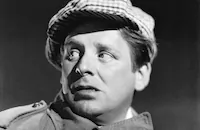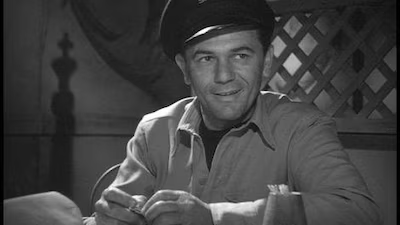The Breaking Point

Brief Synopsis
Cast & Crew
Michael Curtiz
John Garfield
Patricia Neal
Phyllis Thaxter
Juano Hernandez
Wallace Ford
Film Details
Technical Specs

Synopsis
From his home in Newport Beach, California, former P.T. boat operator Harry Morgan rents out his private boat, the Sea Queen , to fishing parties. Harry barely manages to make enough money to support his wife Lucy and their two children, and tired of the financial struggle, Lucy continually begs him to give up the boat and move to her father's farm. One day, Harry is hired to take Hannagan and Leona Charles, Hannagan's attractive blonde friend, fishing off the Mexican coast. While in Mexico, Hannagan abandons Leona and leaves without paying Harry. Desperate, Harry makes a deal with Duncan, a shady lawyer, to transport illegal Chinese laborers into California. In order to prevent his mate, Wesley Park, from becoming involved in the illicit activity, Harry tries to send him back to the United States on the bus, but Wesley and Leona both sneak aboard the boat. Later, Harry docks the boat in a deserted cove to pick up the laborers, but when Mr. Sing, the smuggler, tries to shortchange Harry, a fight breaks out, and Sing is killed. Harry throws his body overboard and returns the Chinese men to the shore. Unknown to Harry, the Chinese, one of whom remembers the boat's name, are picked up by the border patrol, and when Harry reaches San Diego, his boat is confiscated. Later, both Leona and Duncan turn up in Newport Beach. Learning of Leona's presence, Lucy becomes jealous and, deciding that Harry prefers blondes, dyes her hair. Meanwhile, Harry almost succumbs to Leona's seductive attentions, but finally decides to be faithful to Lucy. After Duncan arranges for the "Sea Queen" to be returned, the boat is repossessed by the bank, and Harry is again forced to ask for Duncan's help. Duncan arranges for him to take two gangsters to an offshore boat after they commit a robbery. With money coming in again, Harry is able to get his boat back, and he now concocts a plan to double-cross the gangsters. When she sees him loading a gun, Lucy announces that she is planning to leave him. Nonetheless, Harry goes ahead with his plans, but Wesley becomes involved when he happens by the boat just before the gangsters arrive. After the boat is at sea, the gangsters kill Wesley and throw his body overboard. Harry uses the diversion to get rid of some of the gangsters' guns. He then fakes engine trouble, grabs the gun he has hidden aboard, and attacks the gangsters. During the ensuing fight, Harry is badly wounded. Later, the Coast Guard finds the "Sea Queen." Harry is barely alive, and a doctor asks Lucy for permission to amputate his arm. Lucy, who still loves her husband, convinces Harry to have the operation and save his life. As they leave, Joseph, Wesley's child, waits futilely on the dock for his father's return.

Director

Michael Curtiz
Cast

John Garfield

Patricia Neal

Phyllis Thaxter

Juano Hernandez

Wallace Ford

Edmon Ryan
Ralph Dumke
Guy Thomajan

William Campbell
Sherry Jackson
Donna Jo Boyce
Victor Sen Yung

Peter Brocco

John Doucette

James Griffith
Norman Field
Juan Hernandez
Juan Duval
Benny Long
Paul Vierro
Spencer Chan
Helene Hatch
Donna Gibson
George Hoagland
Bob Maclean
Beverly Mook
John Close
Alex Gerry
Mary Carroll
Glen Turnbull
John Morgan

John Alvin
Dave Mcmahon
Paul Mcguire
Gregg Rhinelander
Bob Williams
Len Hendry
Crew
Edward Carrere
Alan Crosland Jr.
David C. Gardner
Ray Heindorf
Leslie G. Hewitt
George James Hopkins
Ranald Macdougall
Ted Mccord
Leah Rhodes
Sherry Shourds
Norman Stuart
Jerry Wald

Videos
Movie Clip



Hosted Intro


Film Details
Technical Specs

Articles
The Breaking Point
In the Curtiz version, John Garfield plays Harry Morgan, the owner of a charter boat who is having trouble making enough money to support his wife and daughters. When he accepts a charter to take a man named Hannagan and his mistress to Mexico to do some fishing, his client skips out without paying, leaving Morgan with Hannagan's girlfriend Lenora (Patricia Neal), and a docking fee he can't pay. In order to make enough money to get home, Morgan reluctantly agrees to smuggle Chinese people into the United States, but the Coast Guard finds out about it and impounds his boat. The situation becomes increasingly desperate for Morgan as a gang of crooks blackmails him and kills his first mate, forcing him into a fateful confrontation.
In the mid-1940s, Garfield left Warners to start his own production company, but he returned to the studio for The Breaking Point, a film that reunited the actor with director Michael Curtiz. Garfield had previously worked with Curtiz in his movie debut, Four Daughters (1938) and the director's reputation for box office hits was confirmed by his work on Casablanca (1942), Mildred Pierce (1945), and the holiday classic White Christmas (1954). In a pre-production conference on The Breaking Point with Curtiz and screenwriter Ranald MacDougall, Garfield recalled (in Swindell's biography), "I acted all the parts. If Mike [Curtiz] frowned, we'd do some talking, and maybe Randy would do some rewriting. Curtiz wanted to know my secret of being sexy. He decided it was time to get some honest sex into his pictures. I told him I learned everything from [stage and screen actor] Luther Adler, who was a master at making sure all the lights were turned out. I told Mike he should make Luther a technical adviser for all his pictures."
Shortly before filming began on The Breaking Point, an article appeared in the newspaper implying Garfield had a connection to the Communist party. Since he was already under contract for The Breaking Point, Garfield completed the picture, but his career took a downward turn after that. Although Garfield denied ever being a Communist, Swindell stated, "There was no more talk of a new contract offer from Warners, and ominously and suddenly, there were no offers at all. The telephone stopped ringing. Scripts stopped coming his way." Garfield only made one more film, He Ran All the Way (1951), before his death in 1952 from heart problems.
According to Swindell, The Breaking Point "was one of only a handful of studio-mill projects to emerge with honor in that lackluster year." Critics praised Garfield's performance, but since the film performed poorly at the box office, it was forgotten by the time Academy Award nominations were selected.
Director: Michael Curtiz
Producer: Jerry Wald
Screenplay: Ranald MacDougall. Based on the novel To Have and Have Not by Ernest Hemingway.
Cinematography: Ted McCord
Art Direction: Edward Carrere
Music: Ray Heindorf
Cast: John Garfield (Harry Morgan), Patricia Neal (Lenora Charles), Phyllis Thaxter (Lucy Morgan), Juano Hernandez (Wesley Park), Wallace Ford (Duncan).
BW-97m.
by Deborah L. Johnson

The Breaking Point
Quotes
Trivia
Notes
Credits were obtained from copyright records and reviews. "Wesley's" child "Joseph" was played by Juano Hernandez' real-life son, Juan. News items in Hollywood Reporter add the following information about the production: Jack Webb was tested for the second lead. Scenes were shot on location at Balboa and Newport Beach, CA, and at Santa Anita racetrack in Arcadia, CA. Ernest Hemingway's novel also served as the inspiration for Warner Bros. 1945 film To Have and Have Not (see below) and the 1958 United Artists film The Gun Runners, directed by Don Siegel and starring Audie Murphy.

Miscellaneous Notes
Released in United States 2012
Released in United States August 1997
Released in United States Fall September 30, 1950
Shown at Locarno International Film Festival (50 Years of American Film) August 6-16, 1997.
Completed shooting May 10, 1950.
Released in United States 2012 (Film Foundation Screening Program)
Released in United States August 1997 (Shown at Locarno International Film Festival (50 Years of American Film) August 6-16, 1997.)
Released in United States Fall September 30, 1950













